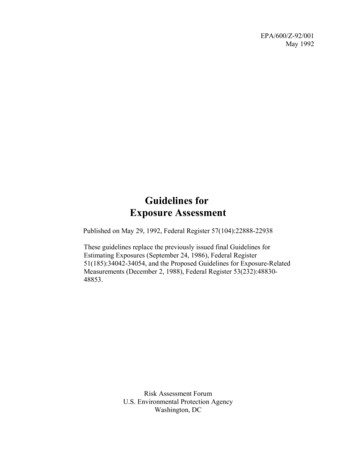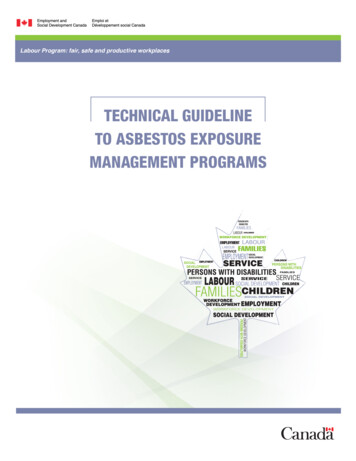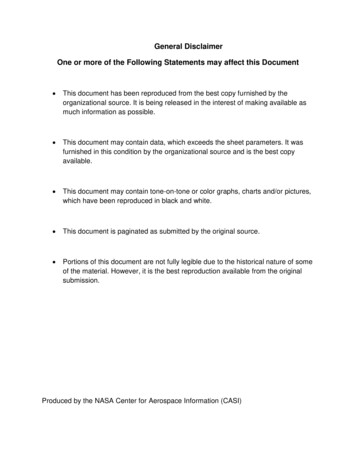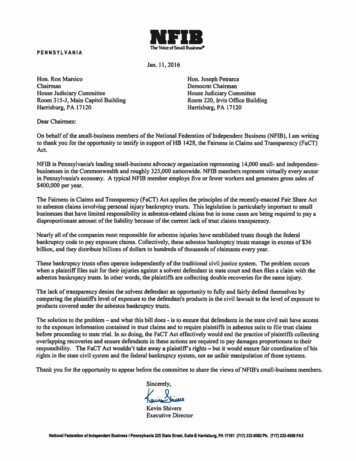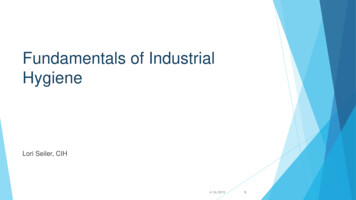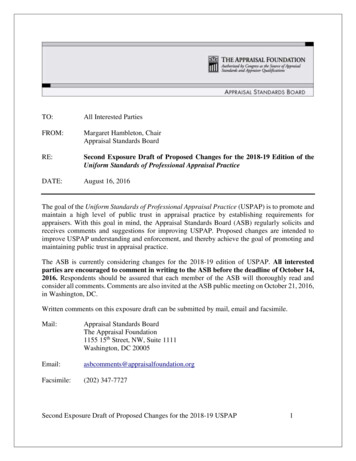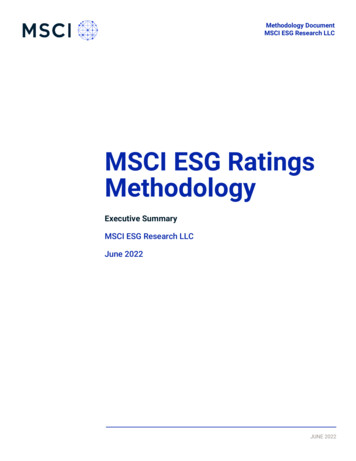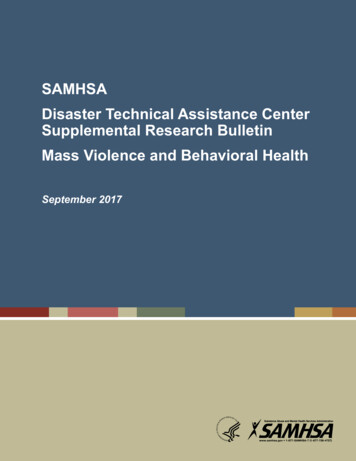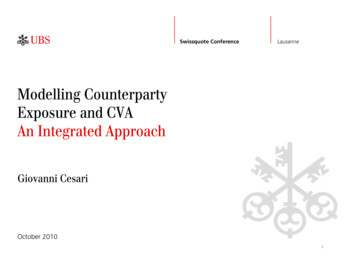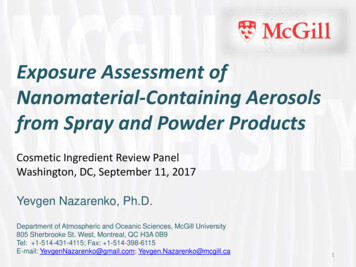
Transcription
Exposure Assessment ofNanomaterial-Containing Aerosolsfrom Spray and Powder ProductsCosmetic Ingredient Review PanelWashington, DC, September 11, 2017Yevgen Nazarenko, Ph.D.Department of Atmospheric and Oceanic Sciences, McGill University805 Sherbrooke St. West, Montreal, QC H3A 0B9Tel: 1-514-431-4115; Fax: 1-514-398-6115E-mail: YevgenNazarenko@gmail.com; Yevgen.Nazarenko@mcgill.ca1
1 – 100 nm in PerspectiveInfluenza AVirusGlucose̴1 nm̴10 ructure-thumb9252986.jpg̴100 nm2
Nano-sized Particles and MaterialsThe US National Nanotechnology Initiative(NNI) defines nanotechnology as “theunderstanding and control of matter atdimensions between approximately 1 and100nanometers,whereuniquephenomena enable novel applications”(National Science and Technology Council,2007).Under the EU’s “Recommendation on thedefinitionofananomaterial(2011/696/EU)”“A natural, incidental or manufacturedmaterial containing particles, in anunbound state or as an aggregate or as anagglomerate and where, for 50 % or moreof the particles in the number sizedistribution, one or more externaldimensions is in the size range 1 nm 100 nm.” *Includes some 50 % and 1 geForSaleItem a5b33 medium.jpeg
Nano-objects Nanomaterials Nano-objects can exist both as free nanoparticles and theiragglomerates / aggregates or be attached to / incorporated intolarger particlesSample 1Sample 24
NOAA: Nano-objects, agglomerates ew.aspx
Human Exposure to Nanomaterials Human exposureto nanomaterialsis associated withpotential healthrisks; Different routes ofthis exposure arepossible:ingestion,dermal,inhalation6
Health Concerns of Nanomaterial ExposureThe size distribution and structural state of matter at the nanoscaleaffects its toxicity and associated biological and health effectsrelative to mass dose of chemically the same substance: Example 1: graphite-derived carbon nanoparticles (median diameter 36nm) were found to translocate from the respiratory system to theolfactory bulb of the rat central nervous system. The same effect wasfound for the manganese oxide nanoparticles (median diameter 30 nm)with resulting inflammatory changes*7*Elder A, Gelein R, Silva V, Feikert T, Opanashuk L, Carter J, et al. 2006. Translocation of Inhaled Ultrafine Manganese Oxide Particles to the Central Nervous System. Environmental Health Perspectives 114(8): 1172-1178;Buzea, C., Pacheco, I.I., Robbie, K. 2007. Nanomaterials and nanoparticles: Sources and toxicity. Biointerphases, 2(4): MR17-MR172;
Health Concerns of Nanomaterial ExposureToxicity of nanomaterials can differ even for smallvariations of particle size and crystal structure: Example2:followingintranasal instillation, amore intense inflammationresponse resulted in miceexposedto21-nmanatase/rutile nano-TiO2compared to 5-nm anatasenano-TiO2.**Grassian VH, Adamcakova-Dodd A, Pettibone JM, O'Shaughnessy PT, Thorne PS. 2007. Inflammatory response of mice to manufactured titanium dioxidenanoparticles: Comparison of size effects through different exposure routes. Nanotoxicology 1(3): 211-226;Buzea, C., Pacheco, I.I., Robbie, K. 2007. Nanomaterials and nanoparticles: Sources and toxicity. Biointerphases, 2(4): MR17-MR172.8
Health Concerns of Nanomaterial ExposureDifferencesandsimilarities betweencarbon nanotubesand asbestos fibersduring mesothelialcarcinogenesis:The mechanism offiber entry into thecellsCancer ScienceVolume 103, Issue 8, pages 1378-1390, 14 JUN 2012 DOI: full#cas2326-fig-00019
Health Concerns of Nanomaterial ExposureMice receiving both a knowncancer initiator,methylcholanthrene, plusinhalation exposure tomultiwalled carbon nanotubes(MWCNT)1 were significantlymore likely :1. to develop tumors – 90%incidence and largertumors;2. have more tumors thanmice receiving the initiatorchemical alone: all miceAlveolar Bronchiolar Carcinoma of thedeveloped tumors ( 3.3Lung with Metastases in a Blood Vesseltumors/mouse lung) vs.(arrow).only 50% of micedeveloped tumors with 1 Inhalation exposure at 5 mg/m3 for 15 days, 5 hrs. per day10 1.4 tumors/lung). cnt/
Health Concerns and Regulation Nanoparticles can be found ubiquitously in industrial andconsumer products, claimed to contain nanomaterials andproducts not marketed as nanotechnology-based (regularproducts). Nanomaterial exposure is possible - bothoccupational and end-user? It is a challenge for modern analytical techniques to determineif nanoparticles, found in the products, are engineered orderived from natural ingredients. Manufacturers do not usuallydisclose such information about ingredients in their products.Some regulations mandate disclosure of thisinformation? Future regulations will likely require it too. Inconsistency between advertising and marketing and the defacto “nano-status” of products that exist in the absence ofregulations mandating accurate reporting of this information.
Nanotech Products Exposure Dermal and inhalation exposure may be especially high fromnanotechnology-based consumer sprays and /uploads/pics/hhroutes280.426.jpg
Our Research: Nanoproduct Selection The nanotechnology-based products were selected from theWoodrow Wilson Nanotechnology Consumer ProductsInventory* that currently contains 1300 such products*Woodrow Wilson International Center for Scholars, 2010 r/
Non-Nanotech Products We added Regular products in our studies to study if and howtheir particulate composition and potential for inhalationexposure differ from the nanotechnology-based jpg
Problems Our Work Aimed to Address Presence and content of nanomaterials inconsumer products on the market were largelyunknown; Potential of human exposure to nanomaterialcontaining aerosol particulate matter, releasedduring use of nanotechnology-based productswas unknown; Doses of nanomaterials that may result fromtheabove-mentionedexposurewereunknown.
Aerosol Measurement Techniques High importance of nanomaterials in all size fractions (both 1– 100 nm and above in the agglomerated form) we needto use more than one measurement technique, e.g. SMPSand APShttp://www.tsi.com/ProductView.aspx?id 21939http://www.tsi.com/ProductView.aspx?id 23007 SMPS: Scanning Mobility Particle Sizer APS: Aerodynamic Particle Sizer
Methods: All Aims Transmission Electron Microscopy (JEOL 2010F) to analyzeparticle size, shape, and agglomeration in the consumersprays and cosmetic powdersImage from: e from: http://nobelprize.org/educational games/physics/microscopes/tem/index.html
Methods: Consumer Sprays Photon Correlation Spectroscopy (Brookhaven ZetaPALS 90PlusParticle Size Analyzer) to obtain particle size distributions inspray productsHydrodynamic DiameterParticle 0px.jpg Hydrodynamic diameter (HD) corresponds to the equivalent spherewith the same diffusion coefficient as that of the real particle Additional Explanation of HD
Methods: Cosmetic Powders Laser Diffraction Spectroscopy (Malvern Mastersizer 2000) wasused to obtain particle size distributions in cosmetic technology/laser diffraction/particle sizing.htm Particles passing through a laser beam scatter light at an anglethat is directly related to their size. Additional Explanation of the Principle of Operation
Methods: Cosmetic Powders Realisticexposurescenario:- application of the cosmeticpowders with the suppliedapplicators and sampling inthe way that mimics real lifeapplication and inhalation. Justification of the Sampling Flow Rate
Methods: Consumer SpraysRealistic Spray UseStandard Nebulizers
Tested Consumer SpraysNanoproductSilver Nanospray*Facial Nanospray*Hair Nanospray*Disinfectant Nanospray*Skin Hydrating Nanomist*Wheel Nanocleaner*Regular ProductRegular Silver SprayRegular Facial SprayRegular Hair SprayRegular Disinfectant SprayRegular Skin Hydrating MistNo Alternative Tested*Nanoproduct as per the Woodrow Wilson Nanotechnology Consumer Products Inventory
Results: TEM of Nano Consumer SpraysNanotechnology-based SpraysSilver NanosprayDisinfectant Nanospray Wheel Nanocleaner
Results: TEM of Regular Consumer SpraysRegular SpraysRegular Silver SprayRegular Hair SprayRegular Disinfectant SprayRegular Facial Spray
Results: Consumer Sprays The size distributions of aerosol particles and dropletslikely to be inhaled during product application aredifferent depending on the spraying techniqueUsing nebulizersHandheld sprayer; Mannequin sampler
Selected Results: Nano Consumer SpraysProductTEMC-Flow Nebulizer Collison NebulizerMode Diameter Mode Diameter3 - 65 nm, single particles andagglomerates, spheroidal, solid,beam insensitiveNo particles detectedNo particles detected37 nm30 nm98 nm311 nm61 nmNo data (foaming)85 nmNo data (foaming)157 nm113 nmMethodSilver NanosprayFacial NanosprayHair NanosprayDisinfectant Nanospray 71 - 214 nm, single particles,spheroidal, solid, beam insensitiveSkin HydratingNo particles detectedNanomist
Results: Regular Consumer SpraysProductTEMMethodRegular Silver Spray 3 - 435 nm, agglomerates andsingle particles, various shapes,solid, beam insensitiveRegular Facial Spray82 - 6000 nm, single particlesand agglomerates, spheroidaland elliptical, beam sensitiveRegular Hair Spray16.5 – 683 nm, single particlesand agglomerates (two types),spheroidal, solid, beaminsensitiveRegular Skin Hydrating 146 - 2500 nm, single particlesMistand agglomerates, spheroidaland elliptical, beam sensitiveC-Flow Nebulizer Collison NebulizerMode Diameter Mode Diameter41 nm41 nm102 nmNo peak(concentration belowwater background)334 nm429 nm102 nmNo peak(concentration belowwater background)
Tested Cosmetic PowdersProductNanopowder M*Nanopowder D*Nanopowder K*Powder FPowder GPowder EPurpose**MoisturizerBlusherSunscreenBlot PowderBlot PowderCosmeticPowder*Nanoproduct as per the Woodrow WilsonNanotechnology Consumer Products Inventory**As per manufacturer
Cosmetic Powders, Confirmed as Nano by TEMNanopowder M(Moisturizing Powder)Nanopowder K(Sunscreen)
Cosmetic Powders, Confirmed as Nano by TEMRegular Powder E (Cosmetic Powder)
Cosmetic Powders, NOT Shown as Nano by TEM Similarities between certain nano and regular cosmetic powders; The “Nano” status of a product does not necessarily mean it containsdetectable nanoparticles.Nanopowder D (Blusher)Regular Powder G (Blot Powder)
Cosmetic Powders, a Special Case – by TEMRegular Powder F (Blot Powder)Nanoscale inclusions, unclear if onthe surface or inside larger particles
Results: Cosmetic Powders (TEM)ProductNanopowder MNanopowder DNanopowder KPowder FPowder GPowder ETEM Range of Particle Diameters, Agglomeration, Shape, Structure,Electron Beam SensitivityPresence of particles 100 nm6 – 45 nmNo separate, all particles are 100nm and agglomerated 5 µm, single particles , irregular, No separate, no agglomeratedsolid, beam insensitive7 nm - 3 µm, only agglomerates, No separate, many agglomeratedangular spheroidal, solid, beaminsensitive12 nm – 8.8 µm, single particles No separate, many in compositesand agglomerates, angularwithin large particlescomposite, beam insensitive62.5 nm – 10 µm, single particles Very few separate, unclear if largerand agglomerates, irregular, solid, particles are or are not agglomeratesbeam insensitiveof nanoparticles23.3 nm – 12.8 µm, singleNo separate, many agglomeratedparticles and agglomerates,and attached to the surface of largespheroidal, solid, beam insensitive particles
Results: Cosmetic Powders In the nanosize range of the SMPS (14.1 nm – 98.2 nm), the aerosolparticle size distribution for 4 cosmetic powders was very similar.Nanopowder K and especially Regular Powder E differed.
Results: Cosmetic Powders In the APS measurement range (0.6 – 19.8 µm), the simulated inhaledparticle concentrations resulting from the application of different powdersdiffered substantially from each other.
Results: Cosmetic Powders (SMPS, APS)ProductNanopowder MNanopowder DPurpose**MoisturizerSMPS, Mannequin HeadSampler: Mode(s)DiameterNot prominent 100 nmAPS, MannequinHead Sampler:Mode Diameter2.5 µmBlusherNot prominent 100 nm3.8 µmSunscreen88.2, 194.6 nm2.1 µmBlot PowderNot prominent 100 nm4.0 µmBlot PowderNot prominent 100 nm3.0 µmCosmetic Powder63.8, 145.9, 414.2 nm2.8 µmNanopowder KPowder FPowder GPowder E
Nanomaterial Dose Assessment Performedpowdersforthecosmetic Calculated for a typical consumer –a female 18 – 60 years old Covered the total 14 nm – 20 µmaerosol particle size range Calculated how much particulatematter (PM) would be inhaled andhow much would deposit indifferent regions of the humanrespiratory system: “inhaled dose”and “deposited dose” per 1-minutecosmetic powder ration and user profiles with movable perstock.com/stock-photos-images/1532R-38004
Methods: Nanomaterial Dose AssessmentInhaled DoseIinh fnano Cinh IHair Tcontact/Bw(1),where:Iinh – inhaled dose of particulate matter per application (ng/kg bw/application);Cinh – mass concentration of particulate matter in inhaled air (ng/L);IHair – inhalation flow rate for a given gender/activity scenario (L/min);Tcontact – duration of contact per application (min);Bw – body weight (kg);fnano – mass fraction of nanomaterial(s) in the inhaled aerosol.Cinh IF Cairwhere:Cair – mass concentration of aerosol particulate matter in the personal breathing cloud;IF – inhalability fraction.It is assumed that the concentration of nanomaterial(s) in the initial product is proportionalto the concentration of nanomaterial in the inhaled aerosol.Equation (1) developed based on Hansen, S.F. et al. (2008) Categorization framework to aid exposure assessment ofnanomaterials in consumer products. Ecotoxicology, 17: 438-447
Methods: Nanomaterial Dose AssessmentDeposited Dose DFregion of respiratory system Inhaled Dose 11 (4),DF HA 1 exp 6.84 1.183ln d p1 exp 0.924 1.885ln d p 0.00352 exp 0.234 ln d p 3.40 2 63.9 exp 0.819 ln d p 1.61 2 d p DFTB 1 1 0.5 1 1 0.00076d 2.8 p 0.0155 exp 0.416 ln d p 2.84 2 19.11exp 0.482 ln d p 1.362 2 d p DFAL 1 1 0.5 1 1 0.00076d 2.8 p 0.9110.943 DF 0.0587 1 exp4.77 1.485lnd1 exp0.508 2.58lndpp where:dp – particle size (µm);DFHA – deposition fraction for the head airways;DFTB – deposition fraction for the tracheobronchial region;DFAL – deposition fraction for the alveolar region;DF – the total deposition fraction of the inhaled particulate matter.(5), (6),(7)Equations (2, 4, 5, 6, 7) from Hinds, W.C. (1999)Aerosol technology: properties, behavior, andmeasurement of airborne particles. New York,NY: John Wiley & Sons, Inc., 483pp
Results: Nanomaterial Dose AssessmentInhaled Dose from 1-minute application of cosmetic powdersLowest mass dose of inhaled particlesHighest mass dose of inhaled particles
Results: Nanomaterial Dose AssessmentDeposited Dose from 1-minute application of cosmetic powders85 – 93% of the total PM deposition Deposited Dose as Percentage of Total PM Deposition
Conclusions I Exposure to ultrafine including engineered nanoparticles cancause or contribute to adverse health effects; Nanoparticles can be found ubiquitously in consumerproducts, claimed to contain nanomaterials as well as“regular” (not marketed as nanotechnology-based) products; Use of nanotechnology-based consumer products can lead toinhalation exposure to single and agglomerated nanoparticles; Existing sampling and analytical techniques do allowcollection and characterization of ultrafine particles includingengineered nanomaterial particles;
Conclusions II By mass, inhaled dose of the aerosol fractions above 100nm is much higher (3-8 orders of magnitude) than ofindividual nanoparticles or their agglomerates smaller than100 nm (nanoagglomerates); By mass, between 85 and 93% of the total deposition ofinhaled particulate matter occurred in the HA region of thehuman respiratory system in the case of the cosmeticpowders we investigated; The head airways and, to a lesser extent, thetracheobronchial region are important in addition to thealveolar region as the deposition sites of nanomaterialcontaining particulate matter.
Conclusions III The particle size distributions in the products and the derivedaerosol are different; For the consumer spray products, different spraying(aerosolization) techniques produce different aerosol particlesize distributions; It is currently hard or impossible to determine if nanoparticles,found in the products are engineered or derived from naturalingredients, especially when manufacturers do not disclosethis information; Both natural and engineered nanomaterials are currentlysubject of the “U.S. EPA Nanotechnology Reporting andRecord-keeping Requirements Rule” under TSCA section 8(a)and will likely be subject of future regulations.
Conclusions IV The European Union already regulates nanotechnologybased cosmetic products. It is unclear if and how the US willfollow in the EU's footsteps, but it may so happen that theissue of inhalation exposure from cosmetic products ingeneral could become subject of regulations in the US. Both natural and engineered nanomaterials are currentlysubject of the “U.S. EPA Nanotechnology Reporting andRecord-keeping Requirements Rule” under TSCA section8(a) and will likely be subject of future regulations.
Questions?Yevgen Nazarenko, Ph.D.Department of Atmospheric and Oceanic SciencesMcGill UniversityRoom 726, Burnside Hall805 Sherbrooke Street West, Montreal, QC H3A 0B9E-mail: yevgennazarenko@gmail.com; yevgen.nazarenko@mcgill.caTel: (732) 470-0201Fax: (514) 398-6115
Health Concerns of Nanomaterial Exposure Example 1: graphite-derived carbon nanoparticles (median diameter 36 nm) were found to translocate from the respiratory system to the olfactory bulb of the rat central nervous system.
